
13 minute read
ILS PRODOTS REGIUNELS
ALOIS “LARRY” SCHNIDRIG WRITING IN THE MAGAZINE “THE ALPS” IN 1935.
Advertisement
Super powers
The Swiss stone pine and its parts: cones, bark, shavings, needles and nuts.
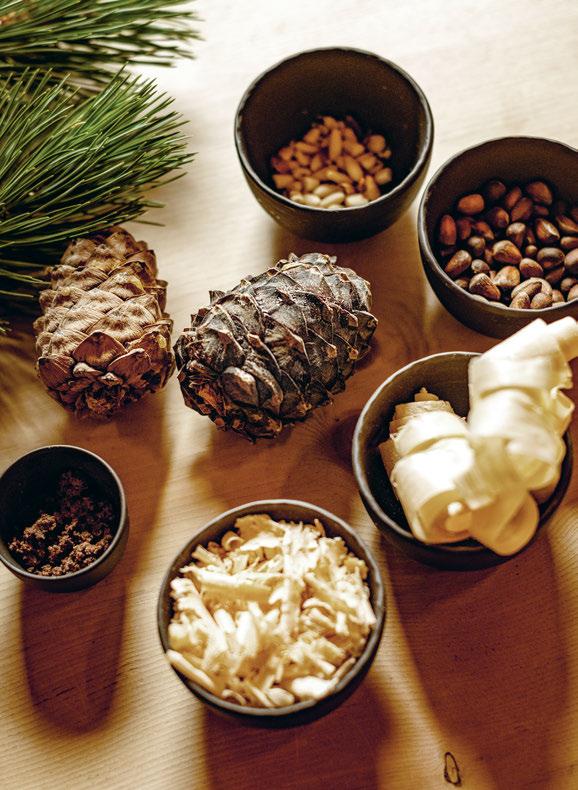
Growth: The Swiss stone pine, also known as the Arolla pine, is often called the “Queen of the mountains”. For good reason: no other tree manages to survive in such harsh conditions, exposed to wind, rain, snow, ice, lightning and rockfall. The conifer grows from an altitude of 1,300 metres up to the tree line at about 2,500 metres, and flourishes in the Engadin. Here, it withstands tem- perature fluctuations from –40 to +40 °C, and grows to an age of several hundred years. The tree starts flowering only after about 60 years; the following year, the female inflorescences grow into cones.
Significance: The Swiss stone pine has great symbolic power. In ancient Roman times, the tree’s cones were a symbol of fertility and immortality. During the Renaissance, anatomists likened a small structure in the brain to the cone: they named it the pineal gland, or Zirbeldrüse in German, which translates literally as “Swiss stone pine gland”. Scholars believed that the human soul was located there.
Uses: Cones contain up to 150 seeds (also known as nuts), each protected by a hard shell. These seeds resemble pine nuts, and are tasty and nutritious. In former days, they were often used in cooking, and were a valuable export product. In the Engadin, the cones are known as “Betschla”, the origin of the local surname Bezzola. It is said that people in the Engadin first made their nut cakes with Swiss stone pine nuts instead of today’s walnuts. Nowadays, the Swiss stone pine is used in a wide variety of products.
Keeping it together: Roland Heuberger prefers to use sheep intestines (here preserved in brine) for his Swiss stone pine sausages, thanks to their finer quality.
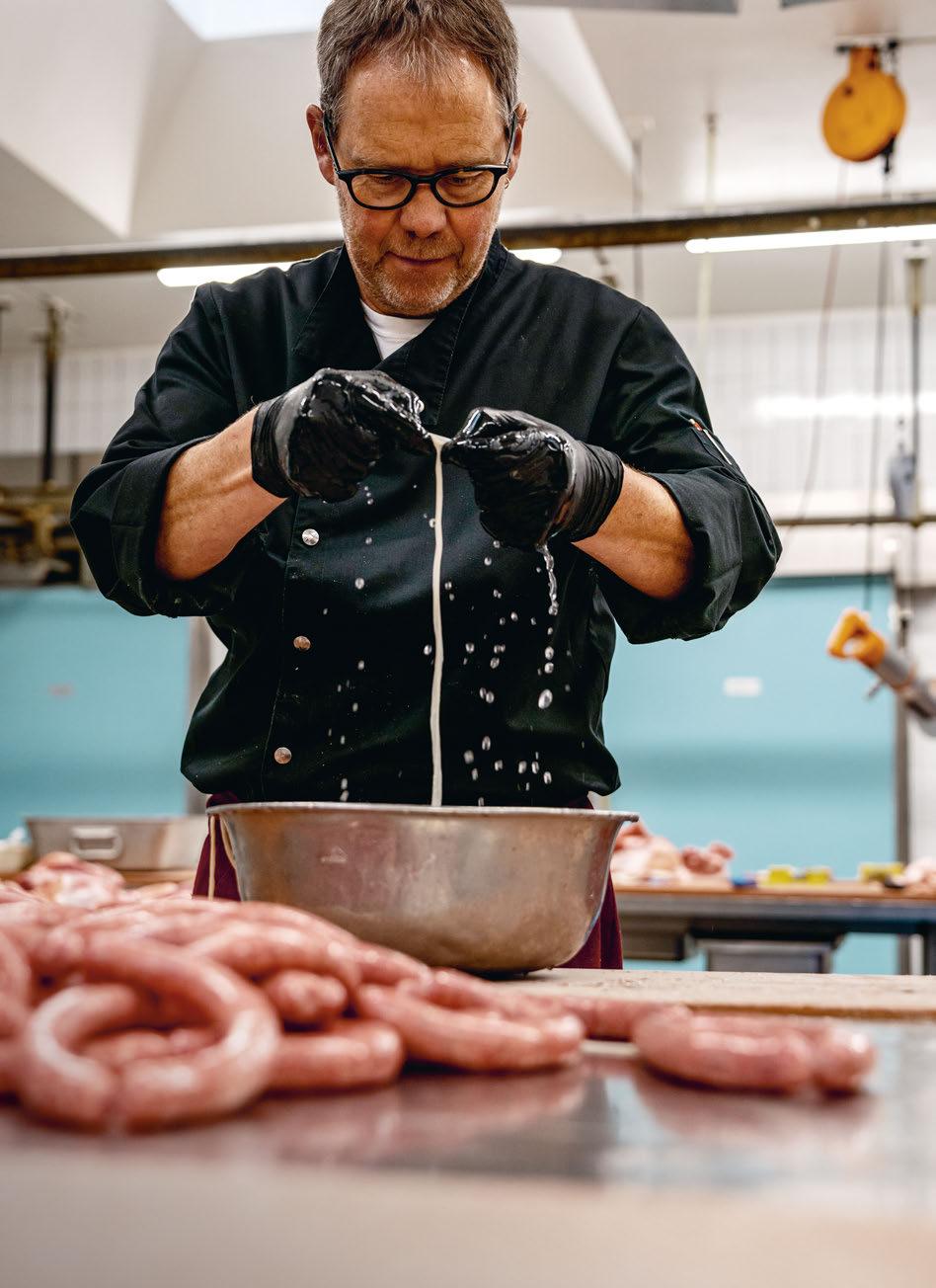
Pine tree in a sausage
The Heuberger butcher’s shop in St.Moritz makes sausages flavoured with Swiss stone pine needles. The result: an exquisite taste of the Engadin, its fragrant forests and pristine nature.
Text MICHÈLE FRÖHLICH Photographs FILIP ZUAN
Roland Heuberger sits among the giants in the forest of “God Ruinas”, just above St.Moritz. Among larches, spruces and Swiss stone pines. One of the latter lies on the ground before him, felled by nature. Autumn has al- ready turned some of the needles brown. This is not the ideal time: normally Roland would come in spring, when the Swiss stone pine trees are still fresh and lush green. When the rain from the previous day is still in the air, and the sun’s rays try with all their might to evaporate the tiny drops from the twigs. And then Roland, with birds singing all around him, would disappear into his own world. He would listen to Phil Collins through his headphones, or maybe AC/DC, to evoke youthful memories, and cut twig after twig from the fallen pine. Today, however, it takes more dexterity and patience to pick out the green needles, which fall one by one into the paper bag between his knees. If you did not know better, you might think Roland was mad.
In fact Roland Heuberger is a butcher, and always has been. His grandfather took over the butcher’s and meat drying facility in St. Moritz in 1946, which had been producing Graubünden air- dried meat since 1906. In those days this was the largest meat-drying plant in Graubünden. Ever since his grand- father acquired the business, it has re- mained in the hands of the Heuberger family. From a young age, Roland would flit around the butcher’s, giving a hand where needed, even though at times he would rather have been play- ing football. But for boosting pocket money, he found that doing the vacuuming and hanging up sausages wasn’t
Roland Heuberger knew from a young age that he wanted to be a butcher, and now takes great pride in his profession.
so bad after all, and he would even be rather proud when he was allowed to operate the grill at the market. He wanted to be a butcher himself one day, he knew that ever since he was little. Eventually he did his apprenticeship in Davos and then worked in St. Gallen, where he also met his future wife, Anita. He did not actually want to return to the Engadin, he wanted to travel the world and work for Anita’s uncle in Canada. But fate had other plans in store.
When one day he received a call from his father saying he did not have enough staff at the business in St.Moritz, Roland did not need long to decide what to do. He was 20 years old at the time – the same age as his youngest son, David, today. From one day to the next, he became responsible for the boning section at the butcher’s: no easy matter, with five butchers all aged between 60 and 65. The experience cannot have been too bad, though, because Roland stayed. Today, he and his two siblings run the business. While Roland is responsible for production and the shop, his brother Erich looks after hotel clients, deliveries and purchases, and his sister Marianne takes care of administration, alongside Roland’s wife.
Small sausage, big flavour
The fact that Roland is now sitting in the middle of the forest collecting pine needles is down to his son, David – who is also following in the footsteps of his father, grandfather and great-grandfather. Two years ago, however, David
was still studying at the commercial college in Chur, racking his brains together with his fellow students trying to figure out what kind of mini-company they could set up for their final-year project. The big idea eventually emerged at the Heubergers’ home, around a kitchen table big enough to seat a family of seven: cured sausages flavoured with Swiss stone pine and hemp. And that was the beginning of the brand “Salzin Engiadinais”.
But first back to the cured sausages. The idea was to make something unusual: a long, thin sausage, handy as a snack for out and about, like Switzerland’s popular Minipics, but premium quality. Roland loved the idea and supported his son, offering his knowledge, facilities and the necessary utensils. Roland would never admit – he is too modest – but without him, the idea would probably never have made it through to production. It took quite a few hours of fiddling and a lot of work before the sausage would be ready for the shop counter.
Success all the way
While it soon became clear that the way to make the hemp sausage would be with roasted hemp seeds, the Swiss stone pine version needed more experimentation. First attempts similarly involved the tree’s seeds, but the final flavour did not appeal. Essential oil from the tree was also ruled out, because it blended poorly with the meat, so that some parts of the sausage did not taste of Swiss stone pine at all, while others tasted too strongly of the essential oil. It took the tree’s needles to do the trick: the sausage was full of favour and almost melted in the mouth like a piece of tender fillet steak. And every bite on a finely chopped piece of pine needle released the unmistakable aroma of Swiss stone pine.
Roland was delighted with the results, and so were the clientele. The students’ sales went well – so well that they were even able to pay out a profit at the end of the project. And that is where
Alongside the traditional and proven recipes, he enjoys trying out new and even slightly crazy ideas.
the story was due to end, because the students wound up the mini-company after a year. But as the sausages had gone down so well, and because Roland enjoys trying out new and even slightly crazy ideas alongside traditional and proven recipes, he wanted to continue producing the sausages. The minicompany gave him the rights, and the story started a new chapter. Last summer, no fewer than 1,500 pairs of sausages were sold every month – an incredible number for such a small sausage.
From tree to sausage: the pine needles are cut from fallen trees or branches and then washed, chopped, dried and frozen before ending up in the sausages.
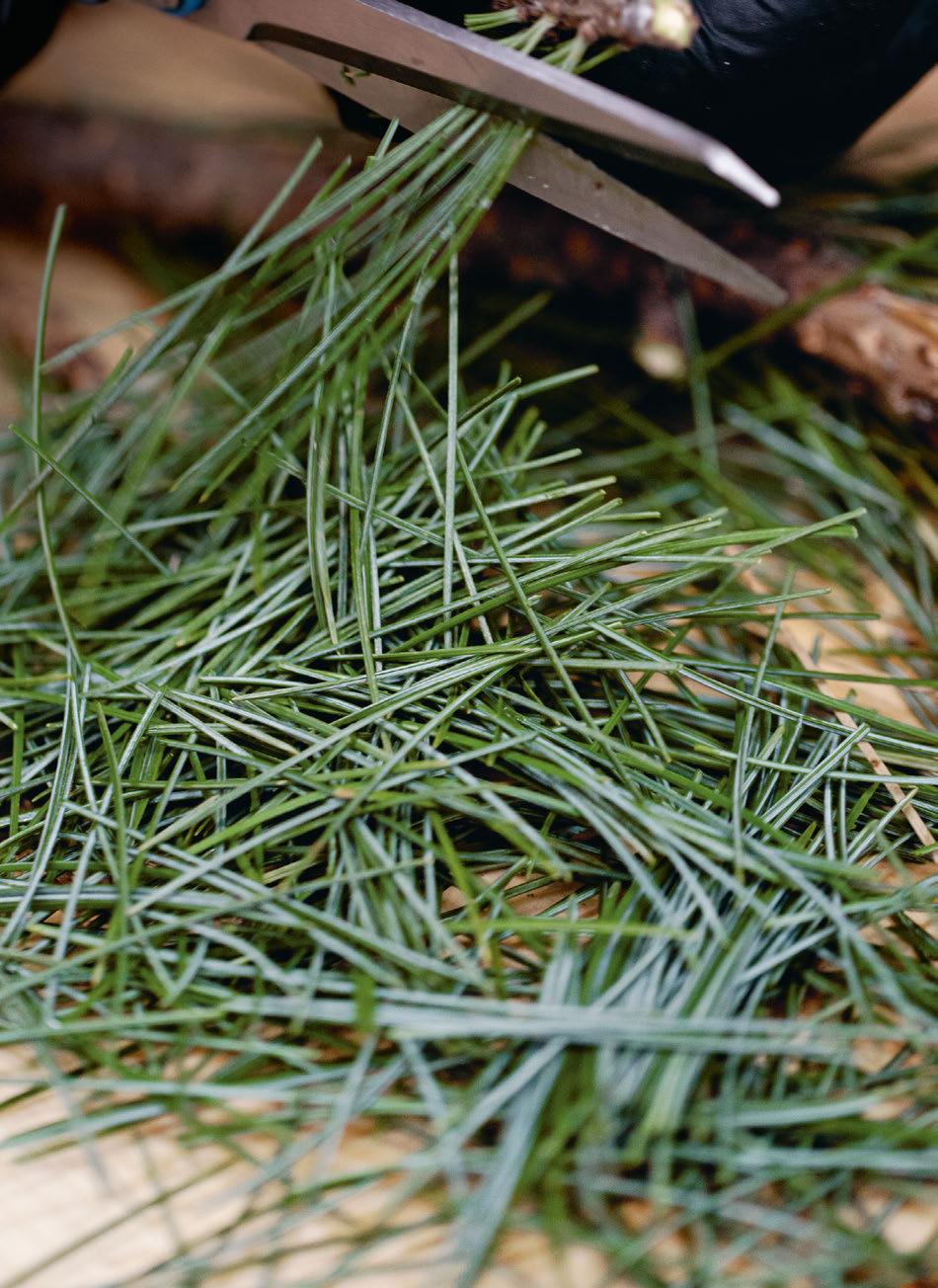
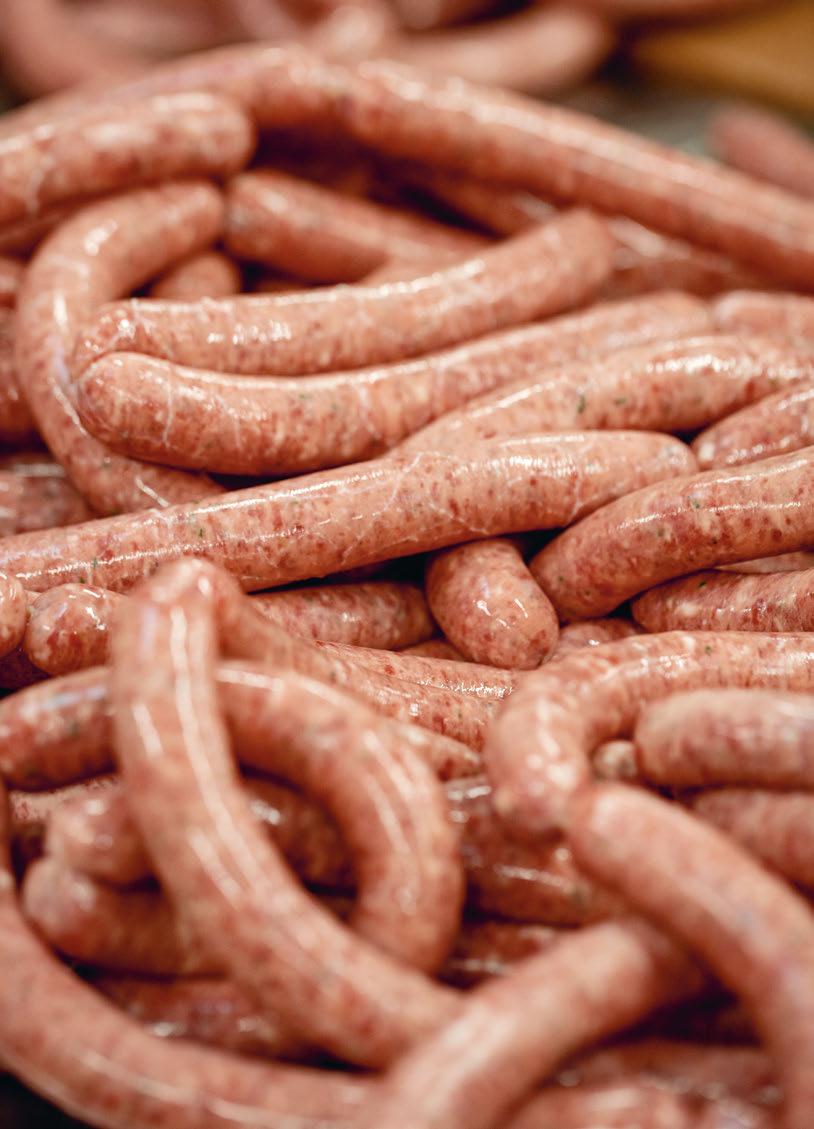
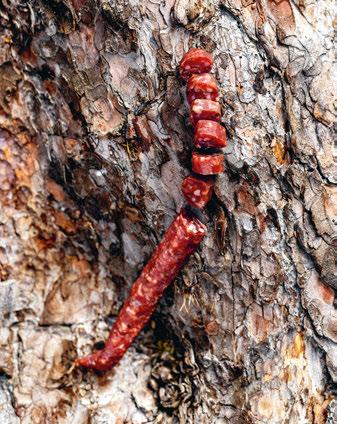
Bite-size bliss: Roland Heuberger still sells the Swiss stone pine sausages under the name “Salzin Engiadinais”.
Coaxed from the pines
Nowadays Roland often sits in the forest, for hours at a time; sometimes together with his wife. He cuts the needles from the twigs. Later he will wash them, chop them up in his old food processor, dry them and freeze them. As the mixer works its magic, the aroma of Swiss stone pine will spread through the cool and sterile rooms of the meat processing plant. Eventually, the needles will be blended with the chopped meat, salt, sugar and spices, and the mixture filled into casings of sheep intestine. The nearly-finished sausages will then be stored in the cold smoking room for four days, briefly smoked, and dried for a week. For now, however, Roland is still working with the scissors. As the needles fall from his fingers and rustle in the paper bag, he starts to talk about his next project: a boiled sausage flavoured with Swiss stone pine. It might mean he would have to spend a few more hours in the forest. One thing is clear: he would be more than happy to.
Buy direct from the butcher
The Heuberger family’s shop (Metzgerei Heuberger, Via da l’Alp 1, St.Moritz) is open Monday to Friday, 7.30am to 12.15 pm and 2.30 to 6.15 pm; and Saturday, 7.30am to12.15 pm and 2 to 4 pm. In addition to cured sausages, air-dried meat and other meat products, the shop also sells other specialities from the valley. metzgereiheuberger.ch
110
A tree’s many faces
The abundance of Swiss stone pines with their refreshing scent has inspired many artisans to create wonderful products from the tree in workshops throughout the valley. The choice is wide, from furniture and decorations to food and drink; many required considerable experimentation before achieving perfection.
1 Stylish chair
The “pultruna” armchair by Ramon Zangger from Samedan is made of local Swiss stone pine; it was designed especially for the relaxation room at the Mineral Baths & Spa in Samedan. Ramon Zangger has now handed his joinery business over to Stefan Trutmann and his wife Claudia. ramonzangger.ch, schreinerei-trutmann.ch
2 Sweet dreams
Special Swiss stone pine pillows from La Punt are filled with Engadin Swiss stone pine shavings, ensuring a relaxing night’s sleep; they also smell wonderful. arvenatelier.ch room. The bottle’s wooden neck ring is made in S-chanf, like all products from this wood specialist. inlain.swiss
7 Cool carafe
A hand-turned spherical stopper of Swiss stone pine adds flavour to the water in a shapely handblown carafe from the Hergiswil glassworks. arvenatelier.ch
8 Spirit of the Engadin
Corina and Noldi Clalüna have been making spirits and liqueur with Swiss stone pine cones in Sils for more than 10 years: the scent of the forest precedes a warm glow in the stomach. arvenschnaps.ch
3 Stimulating soap
The Swiss stone pine soap from Savun Engiadina in Bever contains the tree’s essential oils as well as pieces of pine needle for a pleasant peeling effect. savun-engiadina.ch
4 Say cheese!
The Lataria Engiadinaisa dairy in Bever has combined the taste of fresh Engadin mountain milk with the flavour of Swiss stone pine to produce a delicious cheese. lesa.ch
5 Needles in oil
The Butietta farm shop (Föglias 5, Sils) sells a variety of Swiss stone pine products such as pineflavoured olive oil.
6 Heavenly scents
The stylishly packaged Swiss stone pine fragrance diffusers from In Lain add a pleasant scent to any
9 Special whiskies
Two whiskies made by Orma, “Larix” and “In Lain”, mature in an impressive timber store in S-chanf at the gateway to the Swiss National Park. “In Lain” gains its unique and unmistakable Engadin flavour thanks to a cask finishing in Swiss stone pine. ormawhisky.ch
10 Tea, please!
The blend from Glattfelder in St.Moritz contains Valposchiavo herbs, Engadin Swiss stone pine wood and elderberries. glattfelder.ch
11 Furniture
The Rominger joiner’s workshop in Pontresina creates furniture using local timber, such as a twin-door Engadin chest of Swiss stone pine: a real eye-catcher either in the bedroom or lounge. rominger.ch
1
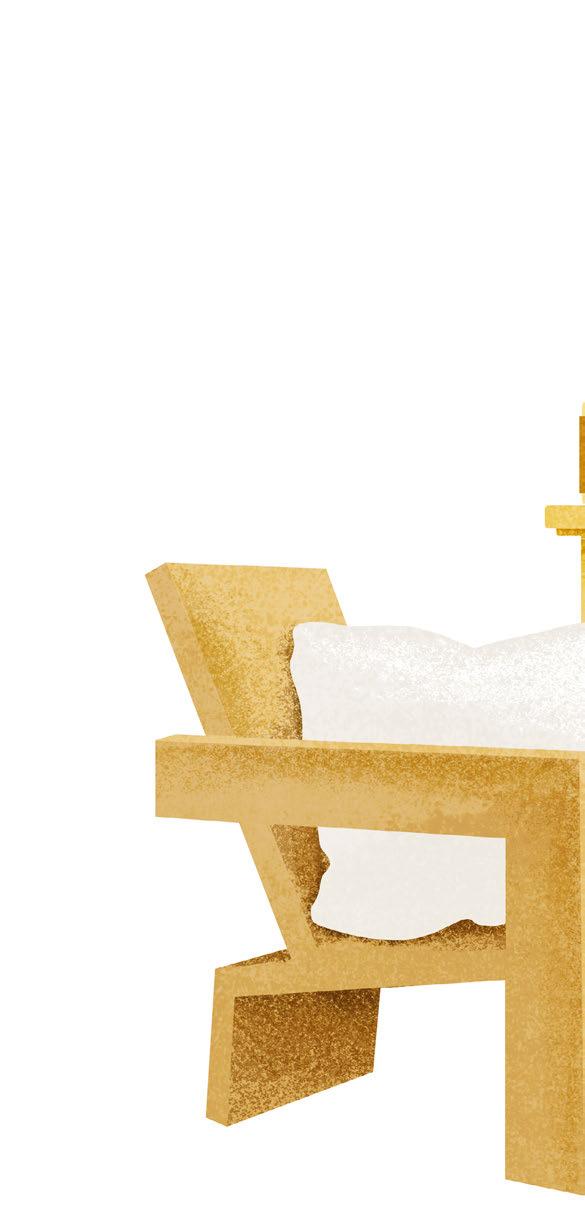
2
5
3 7
6 8 9
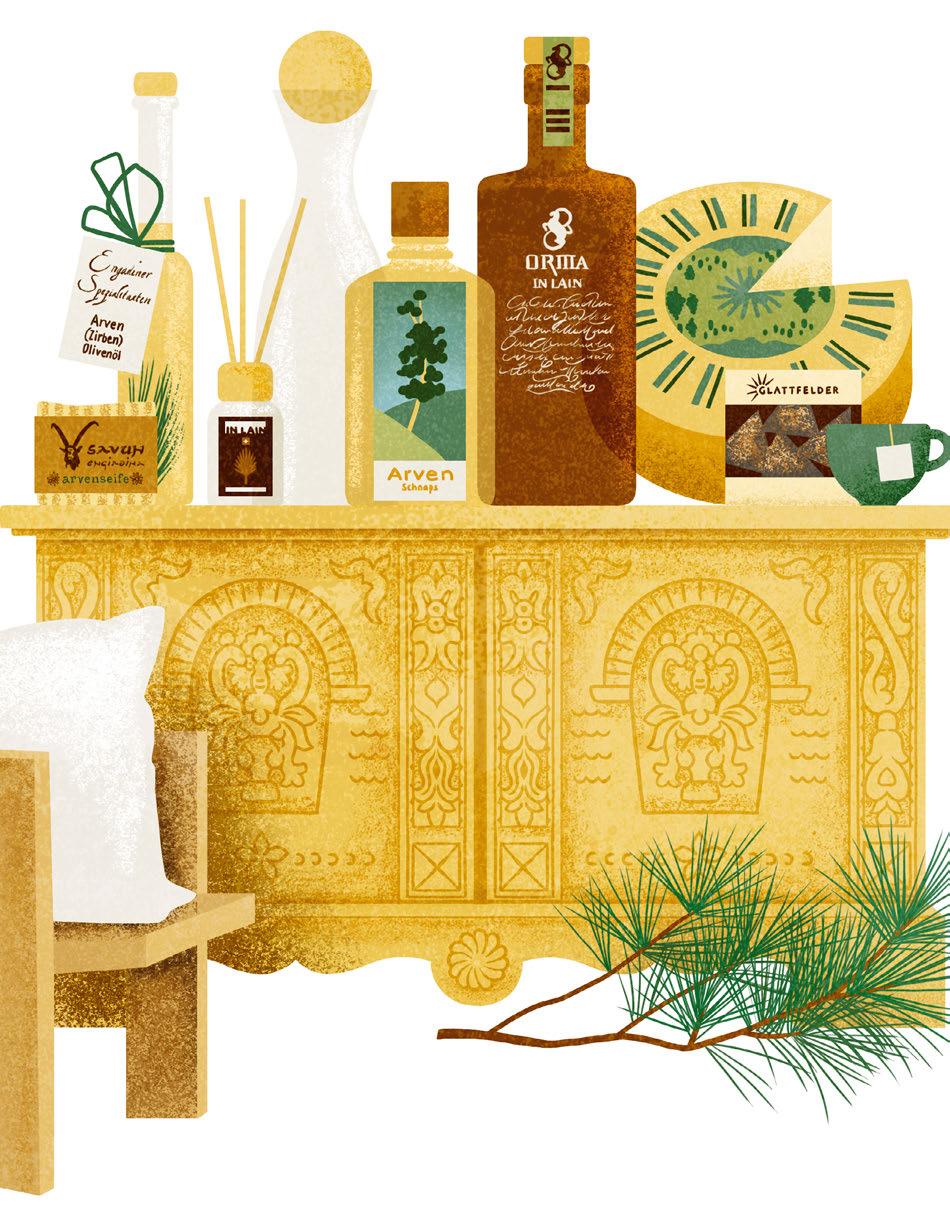
11
In the world of wood
A journey for all the senses
Relaxing view of the forest from the Grand Hotel Kronenhof.
Take deep breaths – and relax
For several thousand years, people in the relaxation in style. Linger in the sauna, Engadin have been taking dips in mineral breathe the calming vapours, then bliss springs and enjoying the blissfully sooth- out in the pool before the panoramic ing water: the springs in St. Moritz were windows and gaze out over the sweeping already known in the Bronze Age. Today, valley with its sweet forest scent of larch the Grand Hotel Kronenhof in Pontresina, and Swiss stone pine: an experience for among others, celebrates the fine art of all the senses. engadin.ch/en/wellness To the wide choice of spas with saunas.
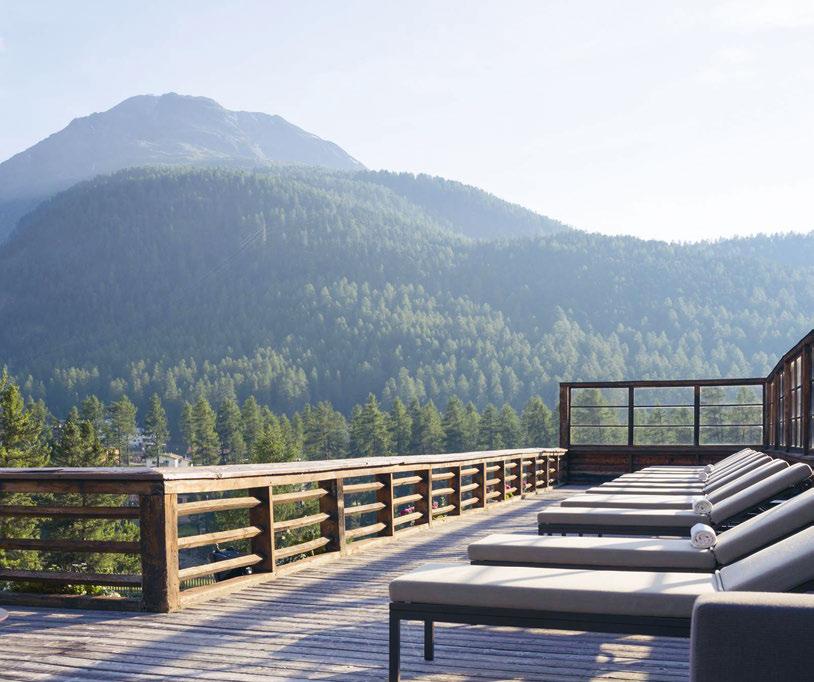
Tree know-how
It is possible to establish the age of a tree by counting its rings, either after it is felled or by taking a core sample. One ring represents one year (in this illustration, 1 ring = 50 years).
The sound of creativity
Zuoz–The imposing, castle-like campus of the Lyceum Alpinum Zuoz is visible from far and wide: the proud clock tower, in particular, cannot be missed. Within the venerable walls of the boarding school, students find plenty of creative spaces in which to develop their artistic talent. Drama, for example, offers them the chance to explore new forms of expression and bring all kinds of stories to life. At the Zuoz Globe theatre, young voices echo from the wooden walls, filling the space with life. Visitors can experience the soundscapes of the Zuoz Globe and the imaginary worlds conjured there during public theatre performances.
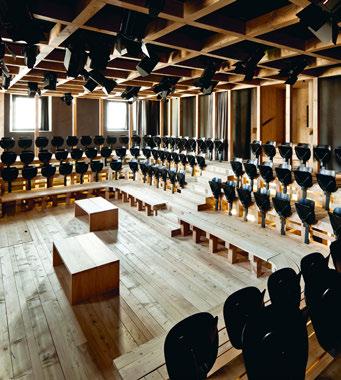
i Theatre at the Lyceum Alpinum Zuoz
Public theatre performances at the Zuoz Globe offer a chance to visit the Lyceum Alpinum Zuoz and experience the innovative school’s unique aura. lyceum-alpinum.ch
Swiss stone pine
Pinus cembra approx. 600 years old 6.7 m trunk diameter Muottas da Schlarigna
Larch
Larix decidua approx. 600 years old 3.77 m trunk diameter Samedan golf course
Attractions in the Val Fex
Forest ride
The Clalüna family’s horsedrawn carriages carry passengers from Sils through fairy-tale forests into the Val Fex. claluena-sils.ch
Wood craft
Fexer knives, forged by Roger Rominger in the Val Fex, carry the spirit of the valley in their blades and handles, made from various different kinds of wood. fexer.ch
Tasty break
At Mangiabain, the Rominger family’s restaurant, attractions include lamb burgers in home-made rosemary buns. fexer.ch
Fine flavours
St.Moritz–The Hatecke family has been celebrating the art of the craft butcher for more than 100 years. The Hatecke branches are known for their superb smoked sausages, cured sausages and fillet steaks – and also their minimalist architecture and fittings. Every day the uncluttered displays showcase the finest delicacies, neatly laid out and beautifully presented. Every slice of sausage enjoys the setting and attention it deserves, like a little masterpiece. A visit to Hatecke, then, is a pleasure for the senses that will linger long in the memory. hatecke.ch
Feel the forest with your feet Fine pine needles will tickle the feet, but they also stimulate them. Visitors can enjoy this invigorating experience – with a little courage – along a variety of “barefoot trails” around Celerina. engadin.ch/en/barfusstrails






